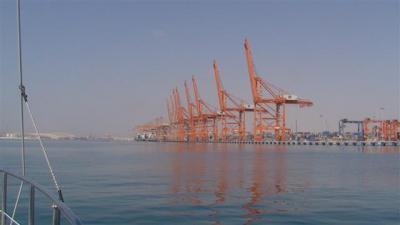This morning the seas smoothed out again and the ride became fabulous. At 0830 local time, Eric hailed Salalah Port Control on the radio. The protocol is to call an hour prior to arrival in port. He gave them all the pertinent details and was told to call back when he got to the breakwaters.
It was a hazy morning, and we couldn’t see land until 0845, and in the distance looked like just a small blob of white contrasted against the blue sea. By 0900, the new breakwater was clearly visible. It so new it is not on our charts. By 1030, land became much clearer. Directly in front of us was a cluster of densely packed white buildings that probably make up the main part of the city. To the left of the city, it looked more industrial, with an odd assortment of buildings grouped in small clusters, ranging from low buildings to high rises, scattered across a dry looking desert back ground. To the right, the shoreline is covered with green trees, with a few buildings cut into the trees along the shore and a few buildings popping out from behind them. It looks like there are large mountains behind the flat shore, but we could barely see the mountains in the haze.
We turned behind the breakwater wall. The water was extraordinarily calm. This is a container port, and the right side is lined with rows of huge cranes for lifting the containers on and off the ships.

As we continued along, on the left, the breakwater Continue reading →
